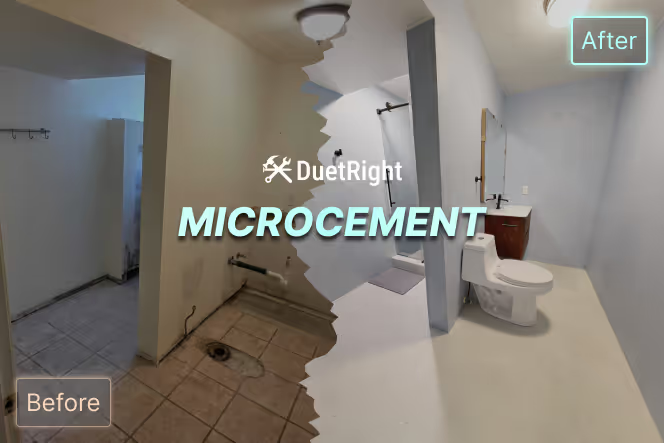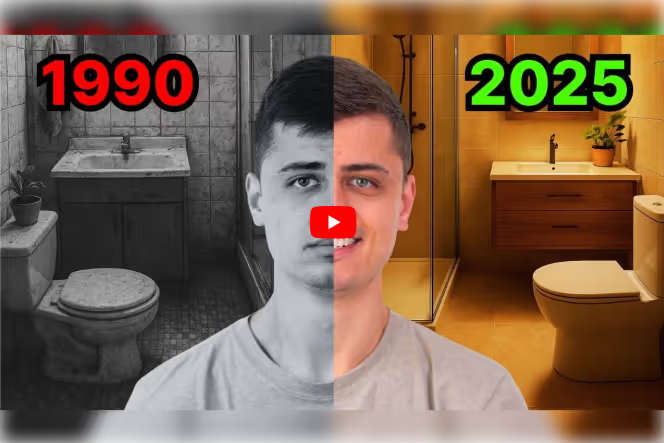We Had 8 Days to Complete a Spanish Tile Steps Renovation Before Guests Arrived
Could we source the tile, prep the steps, and complete a full Spanish-style transformation in less than a week?
.avif)
Angela’s front steps had seen better days. The concrete was chipped and worn, and the paint no longer matched the charm of her Madison Park home.

She was over it. She wanted a staircase that felt warm, timeless, and true to the home’s European style.
There was just one catch. Her houseguests were arriving in eight days, and she hoped to have everything done before they stepped through the front gate.
Since we love a nice challenge, we gladly got to work!
Everything had to be done with precision and it had to be done fast. The tile selection, the edging, the layout, even the waterproofing.
If you’re curious how this custom tiling project materialized, we’ve got the whole story from the initial consultation to the final cleanup.
The Vision, The Quote, and The Ticking Clock
After meeting with Angela, we could tell she wasn’t just looking to fix up her front steps. She had a clear design vision and wanted a result that felt like it truly belonged with the rest of her home.
The house had a soft, European feel to it—simple, timeless, and full of character—and she wanted the staircase to reflect that.
Like any project of ours, we started with an in-home consultation.
During the visit, we walked the site with her, talked through ideas, took reference photos, and recorded detailed measurements. She showed us inspiration images and explained her priorities: authentic materials, a bold patterned riser tile, and something that would hold up to the elements without looking like a typical outdoor remodel.
Once we had all the details, we strolled back to our headquarters and met internally to scope the project. We reviewed the specs, made note of lead times for the materials she liked, and sent over a detailed, itemized quote that covered every part of the job from demo to final sealing.
Then we waited. Patiently. Eagerly.
And when she gave us the green light, the countdown was on.
Her guests would be arriving in eight days from our start date, and we knew every hour was precious.
Three Hurdles, Three Creative Solutions
The timeline was tight, but the biggest challenge came before we even stepped on site: the tile Angela had chosen wasn’t available anywhere nearby.
She had fallen in love with a specific patterned porcelain tile for the risers—a bold "Aster" design that tied the whole look together. We called around to our usual suppliers in North Seattle and Everett, but no one had it in stock.
Waiting for a shipment wasn't an option, not with her guests arriving so soon. So Vladimir, one of our lead technicians, took the initiative to track down a supplier in Tacoma that had just enough in stock. He drove down, picked up the tile himself, and brought it back so we could stay on schedule.

Angela was relieved.
But then came the issue of alignment.
Angela had selected an 8-by-8-inch terracotta tile for the stair treads and a matching 8-by-8 decorative tile for the risers. On paper, they were the same size, but in reality, there were slight manufacturing differences—just enough to throw off the grout lines when viewed from a distance.
It was subtle, but noticeable, especially with a pattern as bold as the one Angela had chosen.
Instead of hiding the issue, we brought it to her attention right away. Vladimir and Serhii explained the options clearly and gave her space to weigh the trade-offs.
She decided to move forward, focusing on the overall visual impact rather than chasing perfect grout symmetry. It was a small compromise, but an intentional one, and it allowed the project to keep moving forward without hesitation.

We also had to address the front edge of each step.
Angela initially considered using a painted metal edge, but we knew from experience that painted finishes tend to peel and wear down over time, especially in Seattle’s wet seasons.
We suggested using a solid aluminum stair nosing profile instead—specifically, the Schluter TREP-B. It gave the edge a clean finish, added slip resistance, and offered long-term durability that matched the quality of the tile.
Each of these decisions—sourcing tile, adjusting alignment, and selecting better materials—came down to the same goal: keeping the integrity of Angela’s vision while staying practical and on schedule.
The Step-by-Step Renovation Process
With materials in hand and the clock running, we got into flowstate. Here's each step we took to try and bring her vision to life before the deadline:
Step 1: Site Protection and Demolition
We started by protecting the surrounding walkways and landscaping with drop cloths and ram board. Once everything was secured, we began carefully removing the old tile and mortar bed.
We stripped everything down to the original concrete, which gave us a clean foundation to build on. It also revealed some uneven areas that would need to be leveled out before we could move forward.
Step 2: Substrate Preparation
To correct those inconsistencies and create a flat surface, we applied a self-leveling compound across the staircase. This step may not be visible in the final result, but it’s crucial.
A smooth, even base is what allows tile to sit properly and for the pattern to align cleanly from step to step.
Step 3: Waterproofing the Surface
Next, we applied a liquid waterproofing membrane. Seattle’s climate makes waterproofing non-negotiable, especially for outdoor tile.
To reinforce vulnerable areas, we added fabric into all seams and corners. This created a continuous, watertight seal that would also help prevent cracks from showing through the tile in the future.
Step 4: Tile and Nosing Installation
Once the surface was ready, Serhii mixed the thin-set mortar and began laying the tile. He started with the patterned risers, then followed with the terracotta treads.

Each piece was set with 1/8-inch spacers to keep the grout joints uniform. As he worked, he used a diamond-blade wet saw to make clean, precise cuts.
He also installed the aluminum stair nosing at each step, cutting each profile to fit tightly against the tile for a clean and durable edge.

Step 5: Grouting and Sealing
After the mortar had time to cure, we returned to grout all the joints using a dark gray epoxy grout. This type of grout is incredibly strong, resistant to staining, and holds up well in wet environments.

For the perimeter and expansion joints, we used a color-matched silicone sealant with a backer rod to allow for movement without cracking. Finally, we sealed the terracotta tiles with a breathable, penetrating sealer that protects the surface from moisture and staining while still allowing vapor to escape.
Each day was mapped out in advance. Each task had to land precisely.
And because every phase built on the one before it, the entire crew worked in sync from start to finish.
A Timeless Entryway, Delivered
By the time we cleaned up the last joint and packed away our tools, the entire staircase felt like it had always belonged.
The warm terracotta treads gave the steps a grounded, natural feel, while the patterned porcelain risers added energy and personality without overwhelming the space.

The charcoal grout framed each tile cleanly and tied the design together in a way that felt bold but balanced.
Every edge detail, including the solid aluminum nosing, looked intentional and clean.

Angela walked outside just as we were finishing the final wipe-down. She paused, took it in slowly, then smiled. It was the first time in years, she said, that the front of her house actually felt complete.
And yes—we finished with two days to spare before her guests arrived!
What had started as a simple idea turned into a transformation that elevated her whole home. The staircase wasn’t just functional anymore. It made a statement.

Meet Serhii: The Problem-Solver on Your Project

Every remodel has its technical challenges, but the difference between a project that feels just “good enough” and one that feels truly dialed in often comes down to the person doing the work. For this project, that person was Serhii.
Serhii's been with our team for years, and this staircase gave him the kind of detail-focused challenge he thrives on.
From the first day on site, he took full ownership of the process. When the Aster tile couldn’t be found locally, Vladimir and Serhii didn’t wait around—they found a supplier in Tacoma, coordinated the pickup, and brought it back that same day so we wouldn’t lose time.
During installation, he kept a close eye on spacing, grout line alignment, and how each pattern piece interacted with the next.
When the small size discrepancy between the riser and tread tiles showed up, he was the first to spot it. And instead of brushing past it, he brought it up right away, explained the options clearly, and helped Angela weigh the pros and cons.

It’s easy to overlook the behind-the-scenes moments that make a project successful. But watching Serhii work—cutting each tile with care, adjusting spacing by feel, checking each edge for consistency—you see how much quiet thought goes into getting things right.
This wasn’t just a staircase. It was someone’s home.
And Serhii treated it that way from start to finish.
The Takeaway From Angela's Story
When Angela left us a 5-star Google review after the project, her words were simple and clear:
“Excellent and precise workmanship with detailed explanations of products and timing. The finished product looks amazing.”
It’s one thing to meet a deadline. It’s another to deliver something that feels personal, lasting, and beautiful.
What made this project special wasn’t just the tile or the technical work.. it was the clarity of Angela’s vision and the collaboration it inspired.
She knew what she wanted, trusted the process, and stayed engaged from start to finish.
If you’re thinking about your own custom tiling project in Seattle, it’s worth asking the same question Angela did: What do I want this space to feel like?
Because the right tile, laid with care and intention, doesn’t just cover a surface. It changes how you experience your home every time you walk in.
Explore Recent Posts

Reimagining a Kirkland Bathroom With Microcement

The Story of Tom's Queen Anne Condo Bathroom Remodel


